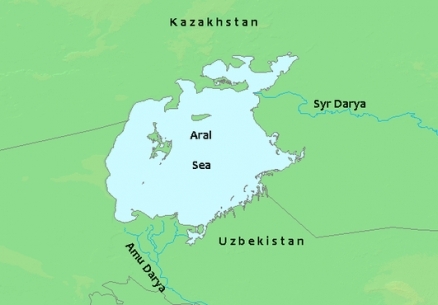Aral Sea
The Aral Sea is an inland saline endorheic lake (lake with no outlet) in west-central Asia on the border between Kazakhstan (north) andUzbekistan (south) has shrunk drastically from its historic size as the fourth largest lake in the world 68,000km2 to a mere 6800 km2
| This article is written at a definitional level only. Authors wishing to expand this entry are inivited to expand the present treatment, which additions will be peer reviewed prior to publication of any expansion. |
by 2008. In 2007 it was reported that "Lake level has fallen 23 m, area shrunk 74%, volume decreased 90%, and salinity grew from 10 to more than 100g/l, causing negative ecological changes, including decimation of native fish species, initiation of dust/salt storms, degradation of deltaic biotic communities, and climate change around the former shoreline." (Micklin)
Recent history of shrinkage
Beginning in the 1960s, farmers and state offices in Uzbekistan, Kazakhstan, and Central Asian states opened significant diversions from the rivers that supply water to the lake, thus siphoning off millions of gallons to irrigate cotton fields and rice paddies. As recently as 1965, the Aral Sea received about 50 cubic kilometers of fresh water per year—a number that fell to zero by the early 1980s. Consequently, concentrations of salts and minerals began to rise in the shrinking body of water. That change in chemistry has led to staggering alterations in the lake's ecology, causing precipitous drops in the Aral Sea’s fish population.
The Aral Sea supported a thriving commercial fishing industry employing roughly 60,000 people in the early 1960s. By 1977, the fish harvest was reduced by 75 percent, and by the early 1980s the commercial fishing industry had been eliminated. The shrinking Aral Sea has also had a noticeable affect on the region's climate. The growing season there is now shorter, causing many farmers to switch from cotton to rice, which demands even more diverted water.
A secondary effect of the reduction in the Aral Sea’s overall size is the rapid exposure of the lake bed. Strong winds that blow across this part of Asia routinely pick up and deposit tens of thousands of tons of now exposed soil every year. This process has not only contributed to significant reduction in breathable air quality for nearby residents, but has also appreciably affected crop yields due to those heavily salt-laden particles falling on arable land.

References
- William S.Ellis. 1990. A Soviet Sea Lies Dying. National Geographic: pp.73–93.
- Rob Ferguson. 2003. The Devil and the Disappearing Sea. Vancouver: Raincoast Books. ISBN 1551925990
- Philip Micklin. 2007. "The Aral Sea Disaster". Annual Review of Earth and Planetary Sciences 35 (4): 47–72.
- New Scientist. 1989. Soviet cotton threatens a region's sea - and its children 18 November issue. New Scientist
- NASA, 2001, The Shrinking Aral Sea.
'
See also
'

